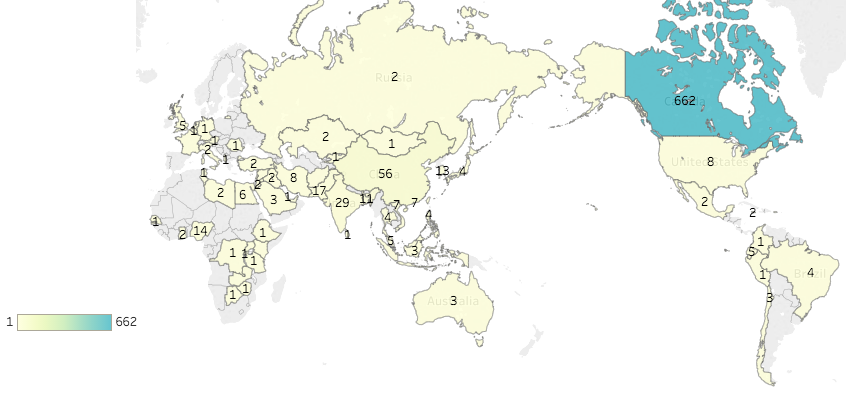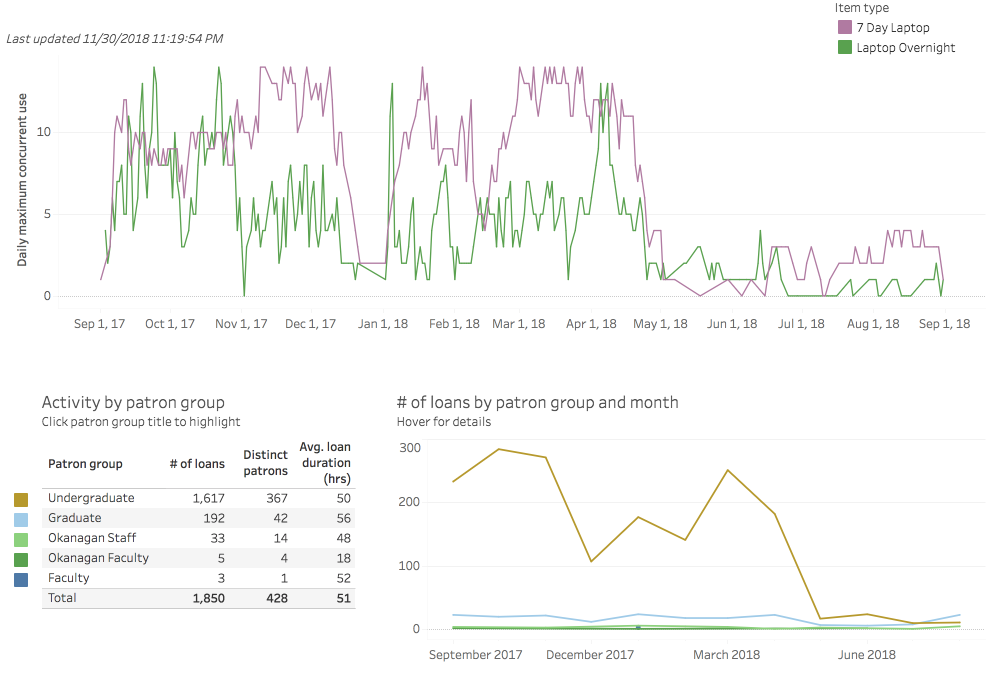Many libraries offer technology loans as a means of addressing issues related to the “digital divide” which includes not only access to the Internet, but access to the technology required to make use of the Internet. While the ubiquity of smartphones and the decreasing cost of personal computers has made this conversation less prevalent in many libraries, technology loans based on this underlying principal remain, and they are expanding into new realms with loans of virtual reality devices, WiFi hotspots, and makerspaces.
In this context, I led a study with my colleagues Jimi Akinsanya, Sajni Lacey and Mathew Vis Dunbar to assess the current laptop lending program at UBC Okanagan Library. Our study posed three questions:
- What can we learn from demographic data about which students are borrowing laptops, in order to improve this service?
- Are there specific demographic groups of students that benefit more or less from the program, and are there elements of the program (such as software available) that could improve the service?
- Are there any insights to be gained from matching circulation data with demographic data that the library was unaware of?
Institutional Context
A quick intro to our laptop lending program is required. We maintain a fleet of 30 laptops and most can be borrowed for 24 hours, with about 10 available for a 7-day loan period. The newer laptops are in the 24-hour category and all of our laptops are in very high demand. Although laptops are available to all students, staff and faculty, undergraduate students are our primary borrowers and were the focus of this study. All of our laptops needed replacement, and this study was intended to inform future purchase decisions as well as addressing the questions above.
Data and results
After obtaining Behavioural Research Ethics Board approval, we compared three years (2016-2018) of laptop circulation data against demographic data available through the UBC Okanagan Planning and Institutional Research Office (PAIR). This allowed us to look at the following variables: age, gender, citizenship, and degree program. Beyond the demographic variables, we were hopeful to have sufficient data points to also look at PAIR survey data (detailed below); this requires students to have completed optional surveys and have borrowed a laptop.
Many first-year students complete a “New to UBC” survey when they first enroll at UBC which includes questions about financial assistance that could be used as a proxy for a socioeconomic variable. Data from this survey were compared against those students who borrowed laptops in an effort to determine whether the laptop lending program is supporting equitable access to technology. However, it was found that for those students who completed the survey and borrowed a laptop in the three-year time period of our study, a limited number indicated that they required financial assistance in their first year, providing insufficient data to draw any conclusions about equitable access and/or financial assistance.
What we did find was that the laptop lending program is used by approximately 5% of the total student population and 9% of the international student population in each year of our study. In 2018/19, UBC Okanagan had a population of 9,935 students, 15% of whom are international students. Gender and age demographics for laptop borrowers are comparable to overall UBC Okanagan statistics. Bachelor of Science students are consistently our top laptop borrowers, which has led to improved science software for our laptops. Students in the Bachelor of Management and Bachelor of Applied Science programs are also regular patrons. For the three academic years of 2016-2018, 1,112 students borrowed our laptops a grand total of 6,747 times, with an average of 7 loans per student.
All of our data analysis was done using Tableau, due to the amazing skills of Meghan Waitt at UBC Library in Vancouver. The maps below show the distribution of patrons by country.
By citizenship, including Canadian students:

By citizenship, excluding Canadian students:

Using Tableau software, we are able to query our LMS, Voyager, to assess concurrent usage of our laptops on an ongoing basis. This table shows loans for the September 2017 – 2018 academic year. Analyzing concurrent usage allows us to determine the number of laptops we should have, and also helps to assess the value of the program.

Beyond our demographic analysis, we also attempted to calculate both return on investment and cost-per-use. As our fleet of laptops was purchased at different times, and the number available is constantly fluctuating due to repairs, these calculations are estimations at best; and they do not account for the cost associated with maintaining and repairing our laptops, cords, etc. By including all unique patrons (1,112) and a conservative average laptop price at $1,182, we were able to calculate a value to students of $1.4 million over three years. However, if we multiply the total number of loans (6,747) by the average laptop price, the value comes in at $7.9 million over three years. In terms of return on investment, these numbers show a significant value to students that require access to technology as part of their post-secondary education. For the library, we can calculate cost-per-use, comparable to how we assess other collections by taking the total cost of the laptops and dividing by usage. For the study period, this leads to a cost-per-use of $7.8. However, if we extend our date range from 2012-2018, as some of our laptops are indeed that old, we get a cost-per-use of $3.7. These calculations were not a requirement of our study, and the extent to which they are estimations must be highlighted, but the calculations are nonetheless informative as a means of assessing the value of technology lending programs in contributing to accessible post-secondary.
Next Steps
At UBC Okanagan, we will have a new fleet of 30 laptops over the next two years. However, simply having a lending program is not doing all that it could to improve equitable access to post-secondary education. Assessing the laptop program data made us think about how to better help students obtain access to the technology they need. Outcomes of this study have led to plans for improved marketing to try and reach a broader set of students, enhanced science-focused software (such as R and Maple) to meet the needs of the students we now know are borrowing our laptops, and the addition of the Sylix language keyboard in an effort to support the UNESCO Year of Indigenous Languages and incorporate inclusivity into all library services.
Barbara Sobol is the Undergraduate Services Librarian at UBC, Okanagan Campus. She is currently on study leave conducting research into the service delivery models in place at academic libraries in BC.

